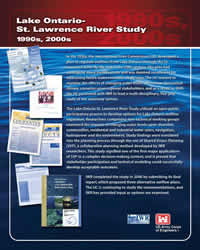 In the 1950s, the International Joint Commission (IJC) developed a plan to regulate outflows from Lake Ontario through the St. Lawrence River. By the end of the 20th century, this plan had undergone many modifications and was deemed insufficient for addressing future water resources challenges. The IJC wanted to examine the effects of changing water levels and various forecasted climate scenarios upon regional stakeholders, and as a result in 1999 the IJC partnered with IWR to lead a multi-disciplinary, five-year study of the waterway system.
In the 1950s, the International Joint Commission (IJC) developed a plan to regulate outflows from Lake Ontario through the St. Lawrence River. By the end of the 20th century, this plan had undergone many modifications and was deemed insufficient for addressing future water resources challenges. The IJC wanted to examine the effects of changing water levels and various forecasted climate scenarios upon regional stakeholders, and as a result in 1999 the IJC partnered with IWR to lead a multi-disciplinary, five-year study of the waterway system.
The Lake Ontario-St. Lawrence River Study utilized an open public participatory process to develop options for Lake Ontario outflow regulation. Researchers comprising nine technical working groups examined the impacts of changing water levels upon shoreline communities, residential and industrial water users, navigation, hydropower and the environment. Study findings were translated into the planning process through the use of Shared Vision Planning (SVP), a collaborative planning method developed by IWR researchers. This study signified one of the first major applications of SVP in a complex decision-making context, and it proved that stakeholder participation and technical modeling could successfully develop acceptable outcomes.
IWR completed the study in 2006 by submitting its final report, which proposed three alternative outflow plans. The IJC is continuing to study the recommendations, and IWR has provided input as options are examined.
Learn More: